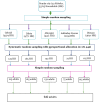Community perceptions and determinants of obstetric fistula across gender lines
- PMID: 39915531
- PMCID: PMC11802775
- DOI: 10.1038/s41598-025-87192-4
Community perceptions and determinants of obstetric fistula across gender lines
Abstract
Obstetric fistula is a major maternal health challenge in low-income countries like Ethiopia. Misperceptions about obstetric fistula delay seeking and accessing healthcare. Understanding community attitudes is crucial for prevention, early detection, and support for affected women. A community-based study was conducted from February 1 to April 26, 2024, among 640 women and men to assess attitudes and influencing factors. Participants were selected using a multistage sampling. Multivariable logistic regression analysis was performed, with a p-value < 0.05 considered statistically significant. The study included nearly equal proportions of males (49.1%) and females (50.9%), with a median age of 32 years (IQR: 19-64). Among participants, 47.8% (95%CI: 43.7-51.6) had a favourable attitude towards obstetric fistula. Those under 20 years (AOR: 7.7; 95%CI: 2.3-28.6), aged 20-35 (AOR: 3.9; 95%CI: 1.8-8.5), and aged 36-50 (AOR: 6.36; 95%CI: 3.0-14.1) were more likely to have a favourable attitude compared to those over 50 years. Female gender (AOR: 1.5; 95%CI: 1.1-2.2), primary education (AOR: 1.86; 95%CI: 1.3-2.9), and awareness of obstetric fistula (AOR: 3.04; 95%CI: 2.0-4.6) were significant determinants. The study revealed unfavourable community attitudes towards obstetric fistula, with notable gender and age differences. Enhancing attitudes requires a comprehensive, tailored program involving all relevant stakeholders.
Keywords: Community attitude; Determinant factors; Ethiopia; Obstetric fistula.
© 2025. The Author(s).
Conflict of interest statement
Declarations. Competing interests: The authors declare that there are no financial and non-financial competing interests. The authors declare no competing interests. Ethics statement: The studies were conducted in accordance with the ethical standard of the University of Gondar (VP/S/10291) and compliance with local legislation and institutional guidelines. The participants provided verbal and informed consent to participate in the study. Consent for publication: Not applicable.
Figures
Similar articles
-
Birth preparedness complication readiness and determinants among pregnant women: a community-based survey from Ethiopia.BMC Pregnancy Childbirth. 2020 Oct 19;20(1):631. doi: 10.1186/s12884-020-03297-w. BMC Pregnancy Childbirth. 2020. PMID: 33076871 Free PMC article.
-
Knowledge of direct obstetric causes of maternal mortality and associated factors among reproductive age women in Aneded woreda, Northwest Ethiopia; a cross-sectional study.Pan Afr Med J. 2017 May 11;27:32. doi: 10.11604/pamj.2017.27.32.10274. eCollection 2017. Pan Afr Med J. 2017. PMID: 28761608 Free PMC article.
-
Knowledge of obstetric fistula and its associated factors among women of reproductive age in Northwestern Ethiopia: a community-based cross-sectional study.BMC Womens Health. 2022 Nov 23;22(1):467. doi: 10.1186/s12905-022-02001-8. BMC Womens Health. 2022. PMID: 36419045 Free PMC article.
-
Deciphering community-level knowledge of obstetric fistula and determinants: perspectives elucidated by ordinal logistic regression.Front Glob Womens Health. 2024 Dec 23;5:1426578. doi: 10.3389/fgwh.2024.1426578. eCollection 2024. Front Glob Womens Health. 2024. PMID: 39763631 Free PMC article.
-
Systematic review and meta-analysis of women's awareness of obstetric fistula and its determinants in Ethiopia.Front Glob Womens Health. 2023 May 19;4:1151083. doi: 10.3389/fgwh.2023.1151083. eCollection 2023. Front Glob Womens Health. 2023. PMID: 37275209 Free PMC article. Review.
References
-
- Lozo, S., Morgan, M.A., Polan, M.L., Sleemi, A. & Bedane, M.M. Disease Control Priorities, Third Edition. 95 (2015).
-
- Sanni OF, Dada MO, Ariyo AO, Salami AO, Afelumo OL, Ayosanmi OS, et al. The prevalence and management of obstetric fistula among women of reproductive age in a low-resource setting. Healthc. Low-resource Setti. 11(1) (2023).
-
- HARMS WC. OBSTETRIC FISTULA. UNFPA (2012)
-
- Meurice, M., Genadry, R., Heimer, C., Ruffer, G. & Kafunjo, B. J. Social experiences of women with obstetric fistula seeking treatment in Kampala, Uganda. Ann. Global Health.83(3–4), 541–549 (2017). - PubMed
MeSH terms
Grants and funding
LinkOut - more resources
Full Text Sources
Medical
Miscellaneous


